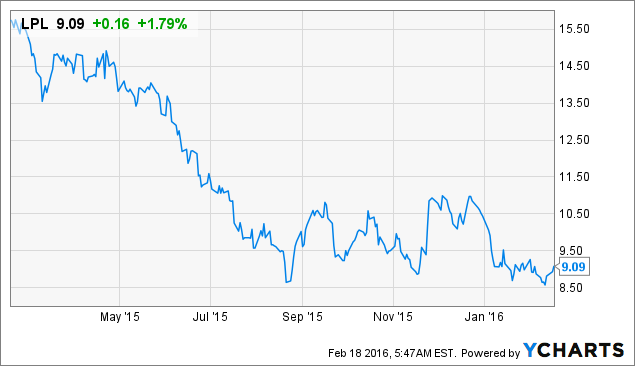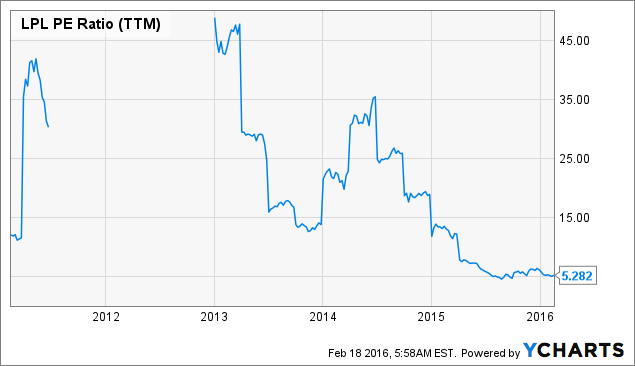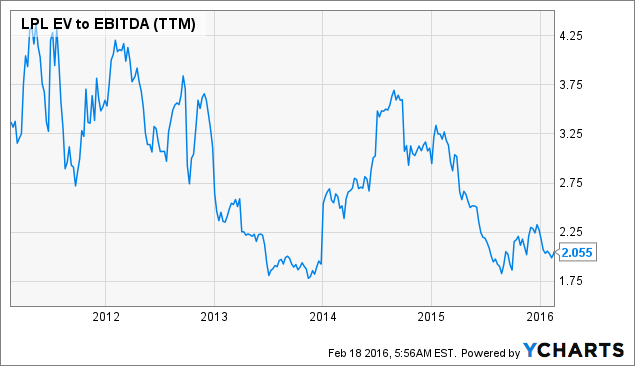LG Display: A Short-Term Casualty Of The Asian Markets; Here Is Why It Is A Fantastic Buy
LG Display: A Short-Term Casualty Of The Asian Markets; Here Is Why It Is A Fantastic Buy
Summary
LG Display is highly undervalued at a P/E ratio of 5.
The company continues to be a leading player across the LCD market.
Moreover, LG Display is a leading innovator for OLED technology.
Given the valuation, I see limited downside risk with very high potential upside.
I forecast an excess of 250% upside for the company over five years, with a 1-year price target of $17-25.
The company continues to be a leading player across the LCD market.
Moreover, LG Display is a leading innovator for OLED technology.
Given the valuation, I see limited downside risk with very high potential upside.
I forecast an excess of 250% upside for the company over five years, with a 1-year price target of $17-25.
If
there is one stock this year that epitomizes the criteria for
asymmetric risk-reward (low downside and high upside), it is LG Display
(NYSE:LPL).
With markets across Asia dropping sharply in response to a Chinese
slowdown, LG Display has been one of the market's victims, dropping from
a price of $14 in May 2015 to $9.09 at the time of writing.

However, an analysis of the company's earnings, valuation and business prospects indicate that such a large price drop is highly unjustified. In this context, this marks a potentially phenomenal opportunity for buyers to initiate a long position at a deep discount.
Company Overview
It is no secret that Asia controls the market for electronic display technologies. Donald Trump is even known to have quoted:
As the above quote from the Donald illustrates, competitors outside of Asia have been relatively small-scale and unable to compete for market share. Over the years, LG Display has succeeded in honing its competitive advantage within the LCD market.
In particular, the company has succeeded in largely differentiating itself from competitors through its capacity for innovation and differentiation. When taking a look at the company's 2015 semi-annual report, we see that LG Display has been at the forefront of product development over the years by being the first to introduce a range of technologies to market. For instance, in 2015 the company was the first worldwide to introduce the Ultra HD OLED (organic light-emitting diode) television (in 55 and 65 inch Ultra HD). While the company has kept its crown as leader of the LCD market, it is also positioning itself nicely to compete in the newer OLED market. In previous years, the company has been known for developing the world's narrowest bezel videowall product, along with the world's first borderless monitor product with 3.5 mm narrow bezel.
More recently, the company has continued to make progress in OLED technology, and has also recently announced a prototype 18-inch flexible screen with rollable capabilities. While these products can invariably be duplicated by competitors, LG Display has shown a continuous capability to be the pioneer for such products and will continue to remain the leader in its industry. In this context, I foresee the company being able to withstand potential for increased competition across this market.
For instance, there is some concern that increased competition across the LCD market by smaller players in Asia has the potential to depress revenues as a result of oversaturation. However, in any market quality will continue to win out. By continuously having the capacity to innovate and introduce new products to market, LG Display will continue to be able to maintain its status as a premium provider and consumers will continue to pay a premium for quality. For instance, the demand for LCD panels for mosaic video walls increased by over 50% in China in 2015, with a 38% increase in demand expected in 2016. LG Display continues to dominate this market.
Not only that, but LG Display appears to be positioning itself nicely for the eventual transition from LCD to OLED technologies. In particular, the OLED market is one that has a capacity for very significant growth, estimated to be worth US$25.9 Billion by 2018. Currently, LG Display is spending $380 million in investment on a factory dedicated to manufacturing OLED screens, which would help to reduce price and make them more competitive with traditional LCD panels. Currently, LG Display is the only company that produces OLED TV panels. OLED provides a superior viewing experience to LCD, with a faster refresh rate and better contrast.
Several of LG's models are bendable and transparent, and OLED TVs are known to use less power than that of LCD. LG refers to this new form of technology as the "Ultimate Display" and describe this as one of the biggest innovations since the introduction of the color TV. As it stands, the only impediment to demand is the fact that OLED TVs typically cost twice as much to produce and accordingly are twice as expensive. Several of LG's models are currently going for approximately $1,800 while high-quality LCD televisions are typically half that price.
However, given the increased investment initiatives in this sector, LG Display will have a first-mover advantage in being able to reap economies of scale by mass producing such televisions at a lower price. Ultimately, LCD will continue to be the industry standard while price remains comparatively lower, but LG Display is positioning itself well to be able to capitalise on an expanding OLED market. Additionally, OLED will also be a major boon to the smartphone sector, with Apple set to purchase OLED display panels from LG for iPhone displays starting from 2018.
Given the above, I remain highly convinced that LG Display will maintain its edge over other rivals. More fundamentally, the above factors provide even greater reason for me to suspect that LG Display is highly undervalued at the current price of $9.09.
Valuation and Growth Scenarios
As we saw above, the stock price of LG Display has no doubt taken a hammering. However, an analysis of historical valuation trends indicate that the stock is trading at very cheap multiples compared with the historical average. For instance, from the below charts we observe a 5-year historical low in both the P/E, and EV/EBITDA ratios:


Moreover, on a terminal P/E basis - taking into account that the P/E ratio over the last two years has ranged from 5 to 35 - we see that the terminal price trades as high as $60 given a 35x P/E ratio.
Additionally, earnings per share in the past three
years has risen by an average of 90%. While I see such growth maturing
and leveling out over the next five years, I still expect growth to
remain vibrant - I certainly take the view that the stock is highly
underpriced given the company's earnings prospects.
For instance, assuming that LG Display grows earnings at an annualised average of 20% per year over the next five years at a 5% discount rate, a terminal P/E ratio of 5 yields a target price of $33, which represents a 270% upside from the current price.
Assuming that the P/E ratio would likely trend higher
under such a scenario, then it would not be surprising to see the actual
target price hit the $40-50 range. However, I foresee a P/E ratio of
10-15 as being realistic given a one-year timeframe, and expect that a
target price of $17-25 within one year is not unrealistic.
Risks
As we can see, China represents LG Display's greatest revenue stream by geography, while TFT-LCD televisions represent the company's greatest revenue stream by product. A decline in performance in either would likely have a very negative impact on financial performance.
One of the major reasons that I really like LG Display is its valuation. No doubt that there are risks associated with investing in this company. However, even with the risks pointed out, the cheap valuation indicates that there is little room for price to go much lower. On the other hand, there is plenty of scope for price to go higher should LG Display continue to vibrantly increase sales and earnings. The industry is set for very significant growth over the coming years, and LG Display is a leading player in its field. In this context, I see the company as having a very favourable asymmetric risk-reward set up. I take a very bullish view on LG Display, and see the current price drop as offering a deep discount to potential investors.

However, an analysis of the company's earnings, valuation and business prospects indicate that such a large price drop is highly unjustified. In this context, this marks a potentially phenomenal opportunity for buyers to initiate a long position at a deep discount.
Company Overview
It is no secret that Asia controls the market for electronic display technologies. Donald Trump is even known to have quoted:
"I just ordered 4,000 television sets. You know where they come from? South Korea. I don't want to order them from South Korea. I don't think anybody makes television sets in the United States anymore. I don't want to order from South Korea; I want to order from here."Alas, Asia will continue to take the crown as leader of this industry. More importantly, LG Display will continue to be the jewel in that crown. Currently, LG Display is the world's largest manufacturer of LCD displays. Aside from competition from other key players such as Samsung and Panasonic, the market for LCD displays remains relatively unfragmented.
As the above quote from the Donald illustrates, competitors outside of Asia have been relatively small-scale and unable to compete for market share. Over the years, LG Display has succeeded in honing its competitive advantage within the LCD market.
In particular, the company has succeeded in largely differentiating itself from competitors through its capacity for innovation and differentiation. When taking a look at the company's 2015 semi-annual report, we see that LG Display has been at the forefront of product development over the years by being the first to introduce a range of technologies to market. For instance, in 2015 the company was the first worldwide to introduce the Ultra HD OLED (organic light-emitting diode) television (in 55 and 65 inch Ultra HD). While the company has kept its crown as leader of the LCD market, it is also positioning itself nicely to compete in the newer OLED market. In previous years, the company has been known for developing the world's narrowest bezel videowall product, along with the world's first borderless monitor product with 3.5 mm narrow bezel.
More recently, the company has continued to make progress in OLED technology, and has also recently announced a prototype 18-inch flexible screen with rollable capabilities. While these products can invariably be duplicated by competitors, LG Display has shown a continuous capability to be the pioneer for such products and will continue to remain the leader in its industry. In this context, I foresee the company being able to withstand potential for increased competition across this market.
For instance, there is some concern that increased competition across the LCD market by smaller players in Asia has the potential to depress revenues as a result of oversaturation. However, in any market quality will continue to win out. By continuously having the capacity to innovate and introduce new products to market, LG Display will continue to be able to maintain its status as a premium provider and consumers will continue to pay a premium for quality. For instance, the demand for LCD panels for mosaic video walls increased by over 50% in China in 2015, with a 38% increase in demand expected in 2016. LG Display continues to dominate this market.
Not only that, but LG Display appears to be positioning itself nicely for the eventual transition from LCD to OLED technologies. In particular, the OLED market is one that has a capacity for very significant growth, estimated to be worth US$25.9 Billion by 2018. Currently, LG Display is spending $380 million in investment on a factory dedicated to manufacturing OLED screens, which would help to reduce price and make them more competitive with traditional LCD panels. Currently, LG Display is the only company that produces OLED TV panels. OLED provides a superior viewing experience to LCD, with a faster refresh rate and better contrast.
Several of LG's models are bendable and transparent, and OLED TVs are known to use less power than that of LCD. LG refers to this new form of technology as the "Ultimate Display" and describe this as one of the biggest innovations since the introduction of the color TV. As it stands, the only impediment to demand is the fact that OLED TVs typically cost twice as much to produce and accordingly are twice as expensive. Several of LG's models are currently going for approximately $1,800 while high-quality LCD televisions are typically half that price.
However, given the increased investment initiatives in this sector, LG Display will have a first-mover advantage in being able to reap economies of scale by mass producing such televisions at a lower price. Ultimately, LCD will continue to be the industry standard while price remains comparatively lower, but LG Display is positioning itself well to be able to capitalise on an expanding OLED market. Additionally, OLED will also be a major boon to the smartphone sector, with Apple set to purchase OLED display panels from LG for iPhone displays starting from 2018.
Given the above, I remain highly convinced that LG Display will maintain its edge over other rivals. More fundamentally, the above factors provide even greater reason for me to suspect that LG Display is highly undervalued at the current price of $9.09.
Valuation and Growth Scenarios
As we saw above, the stock price of LG Display has no doubt taken a hammering. However, an analysis of historical valuation trends indicate that the stock is trading at very cheap multiples compared with the historical average. For instance, from the below charts we observe a 5-year historical low in both the P/E, and EV/EBITDA ratios:


Moreover, on a terminal P/E basis - taking into account that the P/E ratio over the last two years has ranged from 5 to 35 - we see that the terminal price trades as high as $60 given a 35x P/E ratio.
| P/E Ratio | Diluted EPS | Terminal Price (P/E*EPS) |
| 5 | 1.721 | 8.605 |
| 10 | 1.721 | 17.21 |
| 15 | 1.721 | 25.815 |
| 20 | 1.721 | 34.42 |
| 25 | 1.721 | 43.025 |
| 30 | 1.721 | 51.63 |
| 35 | 1.721 | 60.235 |
For instance, assuming that LG Display grows earnings at an annualised average of 20% per year over the next five years at a 5% discount rate, a terminal P/E ratio of 5 yields a target price of $33, which represents a 270% upside from the current price.
| Earnings Per Share Forecast (2016-20) | |||||
| 2016 | 2017 | 2018 | 2019 | 2020 | |
| Projected 20% earnings growth | 2.06 | 2.48 | 2.97 | 3.57 | 4.28 |
| 5% discount rate | 1.97 | 2.25 | 2.57 | 2.93 | 3.35 |
| Terminal P/E Ratio | 5 |
| Terminal P/E * Estimated 2020 EPS | 16.77 |
| Target Price in Year 2020 | 33.5342178854 |
| Upside from price of $9 | 272.60% |
| 5-Year Annualised Rate of Return | 54.52% |
Risks
As we can see, China represents LG Display's greatest revenue stream by geography, while TFT-LCD televisions represent the company's greatest revenue stream by product. A decline in performance in either would likely have a very negative impact on financial performance.
- LCD demand is no doubt booming in China and forecasts point to this continuing. However, the LCD industry is quickly gaining traction in China as smaller players seek to undermine larger rivals. For instance, Chinese companies such as the BOE Technology Group is set to invest $25 billion over the next three years by building seven factories across China. It is suspected that China could in fact overtake South Korea in this context. Should the nature of the industry in China come to favor domestic producers, then LG Display would bear significant financial losses under this scenario.
- Moreover, LG Display is highly exposed to credit risk in China. According to the firm's 2015 semiannual report, credit exposure (in millions of won) in June 2015 was 933.5 million, which accounts for nearly 30% of the company's exposure. Should an economic downturn become prolonged, then resulting losses could significantly hamper financial performance.
- There is always the risk that OLED technology may not play out as anticipated. While OLED is tipped to be the future in the industry, it is LCD demand that is currently booming rather than OLED. It could be the case that the resulting demand for OLED is not enough to justify the high degree of costs in producing products with OLED technology, and a high degree of sunk costs would result under this scenario.
One of the major reasons that I really like LG Display is its valuation. No doubt that there are risks associated with investing in this company. However, even with the risks pointed out, the cheap valuation indicates that there is little room for price to go much lower. On the other hand, there is plenty of scope for price to go higher should LG Display continue to vibrantly increase sales and earnings. The industry is set for very significant growth over the coming years, and LG Display is a leading player in its field. In this context, I see the company as having a very favourable asymmetric risk-reward set up. I take a very bullish view on LG Display, and see the current price drop as offering a deep discount to potential investors.

0 comments:
Post a Comment